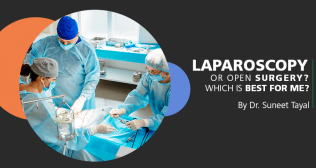
Episiotomy: When Is It Needed, Risks & Prevention
Overview
The onset of childbirth can be an exciting time all around. However, giving birth to a child is also a complex procedure which can pose several complications for the mother. In order to minimize complications and facilitate a smoother delivery, an episiotomy procedure can also be recommended. This procedure which involves the stretching of the perineum to allow the baby to come out safely is called an episiotomy.
What Is an Episiotomy?
In order to assist a woman during the labor process, an episiotomy may sometimes be needed. An episiotomy is a surgical procedure during the second stage of labor wherein an incision is made on the perineum during childbirth. The perineum is the tissue which falls between the vagina and anus. This area is usually numbed following which a small, straight incision is made right in the middle of the perineum in order to make the vaginal opening wider for birth. This is termed as Midline incision (also known as the median). At times, an incision can also be made at an angle (45 degrees) from the bottom of the vaginal opening (on either side) outwards to facilitate a smoother delivery. However, this procedure may take longer to heal. This procedure is termed as a Mediolateral incision.
This procedure is usually encouraged by surgeons if the vagina is not stretching enough at the time of childbirth. Post delivery, the surgeon will stitch the incision and close it.
Reasons for an Episiotomy
There was a time when the primary reason why episiotomies were performed was to avoid the occurrence of spontaneous tearing of the perineum. Another reason was to prevent the occurrence of fetal birth trauma – described as a medical emergency instance where the baby’s head pushes against the perineum for an extended period of time.
However, recent studies have testified to the fact that births without an episiotomy are the best possible outcome for most women in labor. As a matter of fact, as per Medline Plus, it has been revealed that episiotomies tend to heal slower vis-à-vis natural tearing, as the cuts are often deeper. Currently, this procedure has been more or less transitioned into an exception rather than the norm. That being said, there might be a few situations in which this procedure might still be required:
- When the baby’s head or shoulders are too large, might get stuck in the birth canal during delivery and needs a roomier exit through the vagina.
- If the baby’s fetal monitoring shows an elevated heart rate and shows signs of being in distress, then an episiotomy is recommended to speed things up and to prevent the risk of fetal trauma.
- If the mother is unable to stop or slow down the pushing process.
- An episiotomy might be recommended by the surgeon in case there’s a chance of extreme vaginal tearing.
- When there’s a need for instruments such as forceps or a vacuum extractor to be used in order to get the baby out.
- When the baby is coming out in a breech position, i.e. with the feet or rear coming out first and there’s a complication.
Episiotomy Risks
At times, episiotomies are required if the mother and/or baby become compromised and in need of medical attention. However, as with all such surgical procedures, an Episiotomy also carries some risks and in some cases, may even result in several different complications such as:
- There could be a risk of the occurrence of an infection along with a pus discharge from the wound around the incision.
- Possibilities of large tears developing from the incision which might expand through the anus.
- There could be chances of bruising and swelling which could lead to severe bleeding around the tear area (perineal hematoma).
- Episiotomies are not easier to repair than tears and the resultant tear could lead to Perineal pain as well as an extended time of healing.
- Painful intercourse which might need a period of abstinence from sexual intercourse to get better.
- The patient might suffer from a perceived lack of voluntary control over urination/defecation known as incontinence.
Risk Prevention
In order to minimize these risks and reduce the possibilities of an episiotomy, a few activities are recommended that can lower the chances of a woman needing an episiotomy. These are detailed as below:
- Applying warm compresses to the perineum before and during labor with the help of a birth attendant which, in turn, helps in making the tissue around the area become softer, manageable and more flexible. This technique can help avoid occurrences of tearing and facilitate tissue stretching.
- By going on a diet rich in Vitamins C and E as well as and bioflavonoids. Good nutrition and hydration support elasticity in the skin and can help in maintaining tissue integrity.
- Practicing Kegel exercises in order to stimulate circulation to the area and also to promote healing and for improving the muscle tone.
- Maintaining an upright position or alternatively, lying on the side at the time of giving birth.
- Performing perineal massage during the four to six weeks before the expected delivery
- Attending antenatal classes and practicing breathing techniques such as controlling the breathing and the urge to push during labor.
That being said, even if these measures are practiced, a patient may still be in need of an episiotomy. The final call on whether an episiotomy is required will be taken by the doctor depending on how the labor progresses.
Episiotomy Precautions: Care and Healing
After the procedure, being a tender area, chances are there might be soreness in an around the area. Which is why it’s recommended that an individual wait it out for five to six weeks before engaging in any physical activity as it might end up rupturing the stitches. To aid healing and reduce the pain of the incision after an episiotomy, these steps can be taken.
- Frequent sitz baths, a portable bath that is placed over a toilet and covers the vulvar area. This arrangement allows warm water to cover the wound and help speed the healing process.
- Soothing and cooling the sore perineum by making use of ice packs immediately post birth and over the course of the next 12 hours on an intermittent basis.
- Pouring warm water and rinsing with the help of a squirt bottle every time post urination. Also patting the area dry with the help of a clean gauze.
- Using pain relief medications such as ibuprofen, medicated creams, as well as local anesthetic sprays.
- Exposing the wound to as much air as possible and keeping the area clean and dry.
- Drinking lots of fluids and eating a fiber-rich diet to prevent constipation and aid easy bowel movements.



















